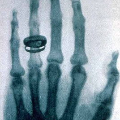Early detection of melanoma is crucial for preventing severe complications and increasing the chances of successful treatment. Existing deep learning approaches for melanoma skin lesion diagnosis are deemed black-box models, as they omit the rationale behind the model prediction, compromising the trustworthiness and acceptability of these diagnostic methods. Attempts to provide concept-based explanations are based on post-hoc approaches, which depend on an additional model to derive interpretations. In this paper, we propose an inherently interpretable framework to improve the interpretability of concept-based models by incorporating a hard attention mechanism and a coherence loss term to assure the visual coherence of concept activations by the concept encoder, without requiring the supervision of additional annotations. The proposed framework explains its decision in terms of human-interpretable concepts and their respective contribution to the final prediction, as well as a visual interpretation of the locations where the concept is present in the image. Experiments on skin image datasets demonstrate that our method outperforms existing black-box and concept-based models for skin lesion classification.
翻译:摘要:早期发现黑色素瘤对于预防严重并发症和增加成功治疗的机会至关重要。现有的基于深度学习的黑色素瘤皮肤病诊断方法被视为黑匣子模型,因为它们省略了模型预测背后的原理,从而危及这些诊断方法的可信度和可接受性。提供基于概念的解释的尝试是基于事后方法进行的,这些方法依赖于额外的模型来推导解释。在本文中,我们提出了一种本质上可解释的框架,通过集成硬注意机制和连贯性损失项来提高基于概念的模型的可解释性,以确保概念编码器激活的视觉连贯性,而不需要监督额外注释。所提出的框架从人类可解释的概念及其对最终预测的贡献以及概念在图像中出现位置的视觉解释方面解释其决策。皮肤图像数据集上的实验证明我们的方法优于目前的黑匣子和基于概念的皮肤病分类模型。

